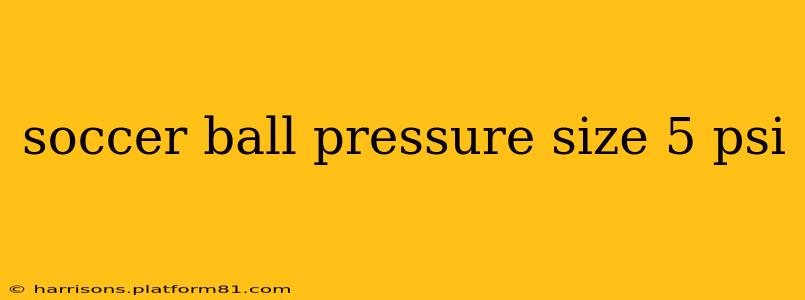Maintaining the correct pressure in your soccer ball is crucial for optimal performance and a safer playing experience. A properly inflated ball enhances control, improves accuracy, and reduces the risk of injury. This guide will delve into the specifics of Size 5 soccer balls and their recommended PSI (pounds per square inch), addressing common questions and concerns.
What is the recommended PSI for a size 5 soccer ball?
The recommended inflation pressure for a size 5 soccer ball is generally between 8 and 11 PSI. However, always check the specific recommendations printed on your ball. Manufacturers might slightly vary their ideal pressure range. This range ensures the ball retains its proper shape and bounce while remaining manageable for players of all skill levels.
Why is the correct PSI important?
Inflating your soccer ball to the correct PSI is critical for several reasons:
- Optimal Bounce: Under-inflated balls have a sluggish bounce, making accurate passing and shooting difficult. Over-inflated balls, conversely, can have a unpredictable, erratic bounce, again hindering play. The ideal PSI ensures a consistent, reliable bounce.
- Enhanced Control: A properly inflated ball provides better control during dribbling, passing, and shooting. Its firmer surface allows for more precise footwork and reduces the likelihood of uncontrolled movements.
- Injury Prevention: Playing with an under-inflated or over-inflated ball increases the risk of injury. A poorly inflated ball can be harder to control, leading to awkward movements and potentially strained muscles or joints.
- Game Regulations: Many official soccer leagues and competitions have specific rules about ball inflation, often requiring balls to be within a certain PSI range.
How do I check the pressure of my soccer ball?
Checking your soccer ball's pressure is simple and requires a basic pressure gauge. You can find inexpensive gauges specifically designed for sports balls at most sporting goods stores.
- Locate the valve: This is usually a small, typically black, valve on the ball.
- Attach the gauge: Securely attach the pressure gauge to the valve.
- Read the pressure: The gauge will display the PSI of your ball.
- Adjust the pressure (if necessary): Use a needle or pump to add or release air to reach the recommended PSI. Always refer to the manufacturer's recommendations printed on the ball itself.
What happens if my soccer ball is under-inflated?
An under-inflated soccer ball will:
- Have a poor bounce: Expect a sluggish, unpredictable bounce, making accurate passes and shots difficult.
- Be harder to control: Dribbling and passing will feel less precise, as the ball will not react as expected.
- Lose its round shape: The ball might become noticeably deformed.
What happens if my soccer ball is over-inflated?
An over-inflated soccer ball will:
- Have an erratic bounce: The unpredictable bounce will impact accuracy and control.
- Be harder on your feet and legs: The harder surface can lead to increased discomfort and potential injury.
- Risk damage: Excessive pressure might cause the ball to burst or weaken prematurely.
How often should I check the pressure of my soccer ball?
It's a good idea to check the pressure of your soccer ball before every game or practice session. Temperature changes can affect the pressure, causing it to increase or decrease over time. Storing the ball in extreme temperatures should be avoided. Regular checks ensure the ball always performs at its best.
What is the best way to inflate a soccer ball?
Use a quality pump designed for sports balls. Avoid using a regular air compressor, as it can easily over-inflate the ball, potentially causing damage. A dedicated sports ball pump allows for more precise inflation control.
By understanding the importance of proper inflation and following these guidelines, you can ensure your soccer ball performs at its peak, enhances your gameplay, and contributes to a safer and more enjoyable experience. Remember to always check the specific pressure recommendations printed on your ball for optimal results.
